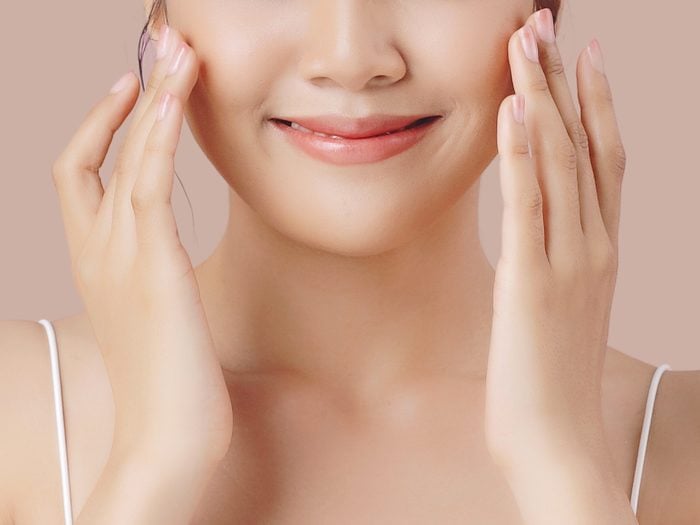Can the Facial Massages on TikTok Really Change Your Face?

Two experts share if it’s possible to massage your face into tautness and what to be cautious of if you’re inclined to give it a whirl.
The concept of shaping your face with your hands has been trending for at least a decade now. It all started with traditional Chinese medicine rituals that became mainstream, with the popularity of using a gua sha tool, jade roller or small suction cups to sharpen your jawline, accentuate cheekbones and lift brows. The techniques work by boosting circulation through lymphatic drainage—the act of pushing lymphatic fluid (which ushers white blood cells between organs) to the lymph nodes. This creates a de-puffing effect, so your features temporarily look a bit chiselled. But recently, a new face-sculpting technique has entered the chat: “The Fascia Strategy,” as one TikToker named Anastasia (no last name) calls it.
For her 300k+ followers, Anastasia describes fascia as being “like a wetsuit that covers the whole body and your face,” and says massaging it is key to depuffing, loosening tight face muscles and boosting circulation to look more youthful.
“Aging isn’t the fault of gravity but the extra liquid in your extracellular matrix,” she said in a video. “By improving blood flow, lymph flow, putting your neck in the right position and doing deep massages to improve micro blood vessels, you will have glowy, smooth skin so you don’t need neuromodulators [a.k.a. Botox].”
Anastasia isn’t the only one talking about the power of massaging the face’s fascia—or dropping terms like “extracellular matrix” into everyday conversation. On TikTok, there are 127 million views of videos related to “fascia massage techniques.”
As a health editor, it’s my job to be skeptical of basically every wellness or beauty fad I see, particularly on TikTok, and especially if it’s coming from a person with no medical background. But my interest will always be piqued by a beauty technique that costs zero dollars. Plus, the before and after pictures Anastasia shares every day are intriguingly convincing.
So, does this really work, or are we being duped?
According to trained medical experts, fascia massage isn’t actually doable. “There’s absolutely no way to massage the fascia for these benefits because you can’t say you’re touching just the fascia—you’re touching everything in between,” says Jackie Sadi, a clinical specialist and field leader in Musculoskeletal Physiotherapy at Western University, School of Physical Therapy in London, Ont.
Fascia lies under three layers of skin, on top of muscle. “It’s a really thin piece of tissue that allows fluids to move between the muscle and the fascia and keeps it all locked in,” says Sadi.
So why are TikTokers clinging to the idea that massaging the fascia is the key to youthfulness? “I think it’s just a fancy word that people like to use,” says Sadi.
Julia Carroll, a dermatologist at Compass Dermatology in Toronto, agrees that massaging the fascia is unlikely to significantly alter face shape. “It’s not supported by scientific evidence,” she says. “The structure and shape of the face are primarily determined by the underlying bones, fat distribution and skin elasticity.”
However, that doesn’t mean massaging your face offers zero benefits—but fascia doesn’t have anything to do with it. Sadi says whenever you touch your skin, you increase blood supply and that creates a fresh-faced look. Also, massaging the skin and muscles helps to relax the face, which can naturally relieve tension, making it look smoother.
Carroll agrees the relaxation and stress-soothing elements of face massages may be the key to its beauty benefits. “When you’re in a relaxed state, blood vessels tend to dilate, allowing for better circulation throughout the body,” she says. Another reason for its beauty benefits is thanks to the aforementioned lymphatic drainage effect. “Gentle facial massages can stimulate lymphatic flow which helps to reduce puffiness,” says Carroll. “By promoting lymphatic drainage, the massage may temporarily decrease facial swelling and improve overall skin appearance.”
Also, Sadi says some doctors recommend face massage to help smooth the layers of the skin and fascia that may have stiffened or bulked after an incision or injury.
The problem is the effects are limiting and aren’t long-lasting—contrary to what some TikTokers may have you believe. “Face massages don’t do anything for wrinkles, sagging or hooded eyes,” says Sadi. “That has to do with the skin, and once they appear, cannot be changed outside of plastic surgery or lasers.” And, while massages can offer immediate beauty benefits and short-term muscle tone, the results don’t last, says Sadi, “especially without addressing stress.”
Not only that, but if you don’t perform the massages the right way, you could create a variety of unwanted skin woes. “Excessive rubbing, pressing or using harsh tools can irritate the skin and disrupt the skin barrier,” says Carroll. “This can cause inflammation, clog pores and potentially lead to the development of acne or other skin issues.” What’s more, certain massage techniques or aggressive moves can stretch or pull the skin, which can contribute to skin sagging or loss of elasticity over time, says Carroll—the exact opposite intended effect. “The skin has a certain level of resilience, but excessive and repeated stretching can damage the collagen and elastin fibres that provide its structure and firmness.”
When in doubt, consult your dermatologist for advice tailored to your own concerns and your skin type—all supported by science.
Next: One of the Most Popular Injectables Right Now Is Something You Probably Haven’t Even Heard of Yet
Renée Reardin is an editor at Best Health and the author of a newsletter called Curious Chat, where she finds answers to beauty questions just like this one. Subscribe below!




